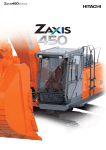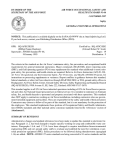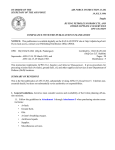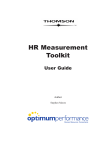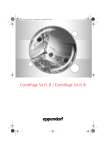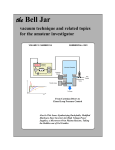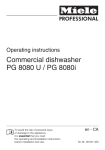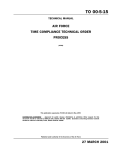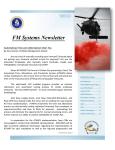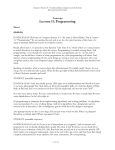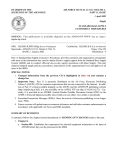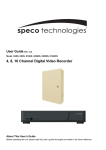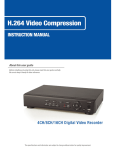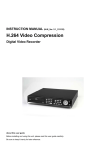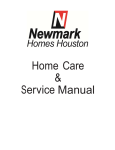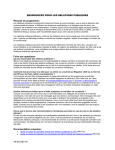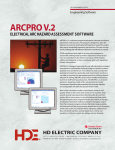Download afman34-129
Transcript
Template modified: BY ORDER OF THE SECRETARY OF THE AIR FORCE 27 May 1997 14:30 AIR FORCE MANUAL 34-129 1 MARCH 1996 Services AIR FORCE SLOT MACHINE CONTROLS AND PROCEDURES NOTICE: This publication is available digitally on the SAF/AAD WWW site at: http://afpubs.hq.af.mil. If you lack access, contact your Publishing Distribution Office (PDO). OPR: HQ AFSVA/SVPCA (Mr William J. Wilcox) Certified by: HQ USAF/SVP (Col Patrick Eagan) Pages: 36 Distribution: F This manual implements AFPD 34-1, Morale, Welfare, Recreation, and Services Programs, by providing guidance and procedures for the Air Force Slot Machine Program. It defines the purpose, explains what the program includes, sets forth responsibilities, and describes how to administer and operate a slot machine program. Other references to the slot machine program are in AFI 34-202, Protecting Nonappropriated Fund Assets, AFMAN 34-212, Control Procedures for Protecting NAF Assets, and AFI 34-209, Nonappropriated Fund Financial Management and Accounting. Proposed supplements are routed through and come from the Major Air Command (MAJCOM) Director of Services (SV) and are not effective until approved by the Headquarters Air Force Services Agency (HQ AFSVA). Chapter 1—OVERVIEW 5 1.1. Slot Machine Program. .............................................................................................. 5 1.2. Locations. ................................................................................................................... 5 1.3. Participants. ................................................................................................................ 5 1.4. Waivers. ..................................................................................................................... 5 1.5. Reports. ...................................................................................................................... 6 1.6. Funding. ..................................................................................................................... 6 Chapter 2—WHAT PEOPLE DO 7 2.1. HQ USAF/SV. ........................................................................................................... 7 2.2. HQ AFSVA. ............................................................................................................... 7 2.3. MAJCOM/SV. ........................................................................................................... 7 2.4. Installation Commander. ............................................................................................ 8 2.5. SV Commander or Director. ...................................................................................... 8 2.6. Membership Support Flight Chief (MSFC). .............................................................. 8 2.7. RMFC. ....................................................................................................................... 8 Slot Machine Key and Lock Accountability. ............................................................. 10 Slot Machine Accounting Technician. ....................................................................... 10 Accounting Technician Forms. .................................................................................. 10 IO. .............................................................................................................................. 10 2.10. Maintenance Technician. ........................................................................................... 11 2.11. Activity Manager. ...................................................................................................... 12 2.12. Activity Cashier. ........................................................................................................ 12 Table 2.1. 2.8. Table 2.2. 2.9. Table 2.3. Activity Cashier Duties. ............................................................................................. 13 2.13. Game Room Attendant. ............................................................................................. 13 Chapter 3—OPERATING PROCEDURES 14 3.1. Background Checks. .................................................................................................. 14 3.2. Game Room Operations. ............................................................................................ 14 3.3. Machine Payouts. ....................................................................................................... 14 3.4. Malfunctions. ............................................................................................................. 14 Malfunction Payouts. ................................................................................................. 15 Machine Tampering and Abuse. ................................................................................ 15 Table 3.1. 3.5. 2 3.6. Slugs, Foreign Coins, and Tokens. ............................................................................ 15 3.7. Signs. .......................................................................................................................... 15 3.8. Security and Machine Placement. .............................................................................. 15 Chapter 4—OPERATING CONTROLS 4.1. 17 Initial Installation. ...................................................................................................... 17 Initial Key Controls. .................................................................................................. 17 Slot Machine Key Controls. ....................................................................................... 18 Financial Section Key Control. .................................................................................. 18 Activity Key Control. ................................................................................................ 18 Activity Key Control. ................................................................................................ 19 IO Key Control. ......................................................................................................... 19 IO Key Control. ......................................................................................................... 20 4.5. LOF File. .................................................................................................................... 20 4.6. Slot Machine Transfer. .............................................................................................. 21 Transfer of Machines. ................................................................................................ 21 Slot Machine Destruction. ......................................................................................... 21 Destruction Guidance. ............................................................................................... 22 4.8. Slot Machine Modification. ....................................................................................... 22 4.9. Slot Machine Denomination Change. ........................................................................ 22 4.10. Slot Machine Storage. ................................................................................................ 23 4.11. Meter Testing. ............................................................................................................ 23 Table 4.1. 4.2. Table 4.2. 4.3. Table 4.3. 4.4. Table 4.4. Table 4.5. 4.7. Table 4.6. Table 4.7. Meter Testing. ............................................................................................................ Chapter 5—CASH MANAGEMENT 5.1. 24 25 Slot Machine Change Fund. ....................................................................................... 25 Establishing and Operating - Slot Machine Change Funds. ...................................... 25 Initial Hopper Fills. .................................................................................................... 25 Initial Hopper Fills. .................................................................................................... 26 5.3. Machines Requiring Other Than Initial Hopper Fills. ............................................... 26 5.4. Machines Temporarily Removed From Service for Maintenance. ............................ 27 5.5. Slot Machine Cash Collection. .................................................................................. 27 5.6. Reconciliation Procedures. ........................................................................................ 28 Table 5.1. 5.2. Table 5.2. 3 5.7. Cash Variances. ......................................................................................................... 29 5.8. SO and SM Transaction Data. ................................................................................... 29 Chapter 6—SLOT MACHINE MAINTENANCE 31 6.1. Maintenance Functions. ............................................................................................. 31 6.2. Training. ..................................................................................................................... 31 6.3. Maintenance Facility. ................................................................................................. 32 6.4. Spare Parts Inventory. ................................................................................................ 32 6.5. Technical Problems. ................................................................................................... 33 6.6. Forms Prescribed. ...................................................................................................... 33 Attachment 1—GLOSSARY OF REFERENCES, ABBREVIATIONS, ACRONYMS, AND TERMS 34 4 Chapter 1 OVERVIEW 1.1. Slot Machine Program. The slot machine program: • Provides a source of entertainment and recreation in a controlled environment where those who choose to play slot machines may do so. • Generates revenues for capital improvements and entertainment programs for morale, welfare, and recreation elements of Services (SV) activities. 1.2. Locations. Slot machines are authorized overseas in clubs (officers', enlisted, and consolidated or collocated), recreation lounges/activities at remote sites, rod and gun clubs, bowling centers, and golf clubhouses where not prohibited by United States law, foreign law, Status-of-Forces Agreement, or other country-to-country agreements. 1.3. Participants. 1.3.1. All categories of personnel authorized patronage privileges in the facility involved in AFI 34-101, Services Programs and Use Eligibility, attachment 1, may participate in the slot machine program. Participants must be at least 18 years of age, unless specified otherwise, both to play or to be in the game area. Sponsors are responsible for presenting proper identification for their guests. Host country personnel who qualify under AFI 34-101 are authorized unless prohibited by Status-of-Forces or other country-to-country agreement, applicable local law, Major Air Command (MAJCOM), Numbered Air Force, or local base supplements to this manual. 1.3.2. The following individuals are prohibited from playing slot machines: • All personnel directly involved in slot machine operations and their families. (This includes slot machine section personnel, slot machine maintenance personnel, and Nonappropriated Fund (NAF) Accounting Office (AO) personnel with duties related to accounting functions or the control of slot machines and keys.) • Other individuals when determined by the installation commander to preclude a real or apparent conflict of interest or to protect an individual from excessive and unaffordable participation. 1.4. Waivers. Operation and internal control waiver requests are sent through the MAJCOM Director of Services to the Agency Commander, AFSVA/CC, 10100 Reunion Place, Suite 500, San Antonio TX 78216-4138. 1.4.1. • • • • Waiver requests include the following information: Manual reference. Background information on the current situation. Problems encountered. Proposed waiver, justification, and benefits to be derived. 1.4.2. Waiver requests are not implemented until approved. The approved waiver is placed in the Life-of-the-Fund (LOF) file and a copy provided to the affected activity. 5 1.5. Reports. 1.5.1. Management Review of Slot Machine Internal Controls. The SV commander or director ensures an annual review of slot machine internal control procedures is conducted with a checklist provided by HQ AFSVA, Director of Programs (SVP). A disinterested third party performs the review. The selected person is not involved in the slot machine program (e.g., may be the NAF Financial Analyst). The completed review is provided to the SV commander or director, MAJCOM/SV, and HQ AFSVA/SVP. The SV commander or director indicates corrective actions for any deficiencies. A copy of the annual review is due at HQ AFSVA, Amusement Branch ( SVPCA) by 1 December. 1.5.2. Slot Machine Status Report. A S l o t M a c h i n e P r o g r a m S t a t u s R e p o r t ( R C S : HAF-SV(A)9499) is required annually. The report is used as an annual inventory of slot machines and slot machine keys. The SV commander or director forwards the status report to HQ AFSVA/ SVPCA, 10100 Reunion Place, Suite 402, San Antonio TX 78216-4138 by 1 November with an information copy to the MAJCOM/SV. Data reflects the status of the program as of 1 October. The report information matches base assigned property records. The SV commander or director and the resource management flight chief (RMFC) sign the report. Note: This report is designated emergency status code D; immediately discontinue reporting data requirements during emergency conditions. The report must include the following information: • Base. • Cash Management Investment Program account number. • MAJCOM. • Annex number. • Name, grade, Defense Switching Network telephone and commercial datafax numbers (include country code) of the following personnel: • SV commander or director. • RMFC. • Slot machine accounting technicians. • Slot machine maintenance technicians. • Activity managers at each activity with slot machine operations. • For each activity where slot machines are located: • Key numbers for machine door (independent observer (IO) and activity), stand door (IO and activity). • A list of each machine (by annex) providing the AF property number, serial number, standard hopper load, personality code, and pertinent comments. • A list of unresolved maintenance problems. 1.6. Funding. 1.6.1. Use appropriated funds to pay for transportation of slot machines and related equipment to and electricity at overseas locations. 1.6.2. Finance all other costs with NAFs. 6 Chapter 2 WHAT PEOPLE DO 2.1. HQ USAF/SV. Issues slot machine program policy and monitors operations. 2.2. HQ AFSVA. Provides guidance on the operation, control, and purchase of slot machines: 2.2.1. • • • • HQ AFSVA/SVP: Coordinates all initiatives impacting on the program. Provides guidance on operations, receiving and analyzing financial reports, and maintenance. Performs MAJCOM functions of control, liaison, and maintenance oversight for MAJCOMs with a limited number of bases. These bases include Howard Air Force Base, Panama, Air Combat Command (ACC), Lajes Field, Azores, Portugal, (ACC) and Thule Air Base, Greenland, AF Space Command. Responsible for the operation, control and purchase of slot machines, games or equipment that can be physically or electronically attached to the slot machines. 2.2.2. HQ AFSVA, Director of Financial Management and Comptroller (SVF) provides accounting and internal control procedures. 2.2.3. HQ AFSVA, Director of NAF Purchasing, purchases all slot machines, and related items. Bases may purchase repair parts for slot machines, but may not purchase parts or items that alter the games, meters, locks, or accounting functions. 2.3. MAJCOM/SV. 2.3.1. • • • Controls: Monitor and support base NAF AO control over slot machines. Provide technical advice, train new personnel, and supervise reporting. Evaluate internal controls to ensure operational efficiencies and adherence to published policies in AFI 34-202, Protecting Nonappropraited Fund Assets. • Review cash collections and monthly machine activity reports provided by HQ AFSVA/ SVPCA, and take corrective actions as required. • Perform staff assistance visits to review base procedures and control; to observe cash collections and maintenance procedure; and to review key controls. 2.3.2. Liaison. • The following items must be coordinated through the MAJCOM/SV for HQ AFSVA approval: • • Requests for purchase, relocation (to unauthorized activities), deactivation, or disposal of machines or related equipment. Operational and internal control procedural waivers. 2.3.3. Maintenance: • Provide technical assistance. 7 • • • • Develop and implement maintenance training programs. Ensure quality control of base technicians' performance. Review and analyze maintenance reports and trends. Coordinate with HQ AFSVA/SVPCA prior to testing new equipment and procedures. 2.4. Installation Commander. • Ensures controls and limits on slot machine operations are established and followed. • Approves NAF council minutes concerning all actions pertaining to slot machines. • Approves the use of assigned military personnel or general schedule (GS) civilian employees to act as IOs on a periodic basis when in the best interest of maintaining executive control of slot machine operations. • Designates, in writing, an individual to observe the destruction of slot machines. 2.5. SV Commander or Director. • Has overall responsibility for the operation of the base level slot machine program. • Designates, in writing, the location of the key containers used by the IO, and the location of the spare keys and spare locks maintained by the NAF AO. • Designates, in writing, two individuals responsible for the slot machine spare keys and spare locks. • Ensures slot machines are placed in HQ AFSVA approved activities. • Ensures management review of slot machines internal controls, and annual status reports are accomplished. 2.6. Membership Support Flight Chief (MSFC). Supervises slot machine maintenance personnel and: • Ensures periodic, unannounced, observation visits of slot machine operations are conducted, documents significant findings, and ensures corrective action is taken. • Ensures all newly hired maintenance technicians receive a briefing outlining their duties and responsibilities. • Coordinates maintenance work schedules between activity managers, the NAF AO, and the maintenance supervisor or lead technician. • Establishes and maintains a training program to enhance skill and knowledge of maintenance employees. • Makes available a maintenance facility with sufficient space, storage area, electrical power, and secure parts storage. • Makes available adequate test equipment and tools to maintain and repair slot machine equipment. • Ensures all maintenance functions are performed according to this manual. 2.7. RMFC. • Supervises the accounting and IO personnel. 8 • • • • • • • • • • • • • • Establishes a training program for slot machine accounting technicians, IO personnel, and other employees involved in slot machine program cash and data collection and reporting. Implements procedures and performs periodic, unannounced observation visits of slot machine operations, documenting any significant findings and corrective action taken. Maintains machine, key, and spare lock accountability using AF Form 1297, Temporary Issue Receipt, and by following the procedures in Table 2.1. The controlled slot machine keys consist of the following keys: Upper Machine Door (UMD), Lower Machine Door (LMD), Upper Stand Door (USD), Lower Stand Door (LSD), Cash Box Release (CBR) and Cash Box Lid (CBL). If appropriate, locks for bill validators are keyed with the same USD, LSD, CBR and CBL locks within each activity to reduce the number of keys required to operate and maintain the slot machines. Controls and issues game key for each slot machine (game keys are the Meter Read and Jackpot Reset Keys that come with each slot machine). Submits slot operation (SO) and slot maintenance (SM) transaction data, Slot Machine Point-of-Entry (POE) Report (RCS: HAF-SV(TW) 94101) to HQ AFSVA/SVPCA the first workday following a cash collection, except for the end of month (EOM) report. Transmits the End of Month Slot Machine POE Report (RCS: HAF SV(TW) 94101) by the third workday following the EOM with the last day of the month as the transaction date. Bases using the Intelligent Tracking System (ITS) slot accounting and management system, which replaces the POE system, submit data files weekly. Note: The Slot Machine POE Report is designated emergency status code D; immediately discontinue reporting data requirements during emergency conditions. Reviews slot machine weekly activity reports received from HQ AFSVA/SVPCA which summarize slot machine operation, taking appropriate corrective action as required. Answers inquiries from HQ AFSVA/SVPCA within five workdays after receipt. Reviews malfunction payments for unusual activity of any machine, game room attendant, or customer. Arranges for another mechanical coin counter when the coin counter is not working properly. Records shortages caused by foreign coins. If a particular type of coin causes significant losses or appears frequently, forwards several coins and reports the problem through the MAJCOM/SV to HQ AFSVA/SVPCA. Inventories all slot machines, keys, and spare locks on 1 October, in conjunction with the annual requirement for the Slot Machine Program Status Report (RCS: HAF-SV(A) 9499). Briefs each IO, outlining duties and responsibilities. Prepares a list of NAF AO personnel restricted from playing slot machines, and forwards it to all activities operating slot machines. Keeps a current copy in the LOF file. Reports any unusual incident involving slot machine equipment, keys, locks or money (regardless of dollar value) to the MAJCOM and HQ AFSVA/SVPCA. 9 Table 2.1. Slot Machine Key and Lock Accountability. # The RMFC 1 signs for machines, keys, and spare locks 2 transfers machines, keys, or locks to activity managers 3 stores spare keys and locks by completing AF Form 1297, and provides the original to HQ AFSVA/ SVPCA and a copy to the LOF file. completing AF Form 1297 the original to the RMFC and a copy to the activity manager. storing in a container separate N/A from service keys with a copy of AF Form 1297. 4 requests replacement locks and preparing and forwarding a a copy to the LOF file. keys letter to HQ AFSVA through the MAJCOM/SV 5 when incoming, assumes completing AF Form 1297 the original to HQ AFSVA/ SVPCA, responsibility for machines, and a copy to the LOF file and both keys, and spare locks RMFCs. 2.8. Slot Machine Accounting Technician. • Analyzes and summarizes financial data. • Maintains and validates program records for cash collection. • Prepares and transmits point of entry POE data using AF Forms 1401, NAF Petty Cash/Refund Voucher, and 2557, NAF Cash Receipt Voucher, and AFSVA Forms 262A, Slot Machine Malfunction Payment Log, 268, Slot Machine Collection Report, and 269, Slot Maintenance Log. Table 2.2.Table 2.2 outlines how the forms are used. • On bases using ITS, the slot accounting technician is responsible for operation of the system and transmission of ITS data to HQ AFSVA/SVPCA. Table 2.2. Accounting Technician Forms. # Form(s) 1 AF Forms 1401 and 2557; and AFSVA Form 262A are 2 AFSVA Form 269 is 3 AFSVA Form 268 is received by the accounting technician each normal duty day from each activity. each normal duty day from the maintenance section. on days of cash collection 2.9. IO. The IO provides independent observation and verification of proper slot machine procedures. The IO must be present whenever the activity manager or designee collects cash or when the maintenance technician opens a machine or stand in the operational area. NAF AO personnel (e.g., slot machine accounting clerk, etc.) may act as IO on a periodic basis, or assigned military or GS civilian employees may be assigned such duty, when the installation commander deems it in the best interest of maintaining executive control of slot machine operations. 10 2.9.1. Monitors all functions associated with the cash collection from the slot machines, including signing for AFSVA Form 268, recording meter readings, and witnessing the removal and counting of coins. Completes AFSVA Form 268 and ensures signatures of responsible personnel are obtained. 2.9.2. Observes and verifies the emptying and filling of hoppers, changing of locks and keys, and performance of maintenance in the operating area. 2.9.3. Obtains the key containers from the designated office, signing AF Form 2432, Key Issue Log. Signs AF Form 2432 for the IO keys at the activity which opens the key container. Maintains total security over the keys at all times. At the end the shift, the IO secures the keys in the container prior to returning them to the designated office. 2.9.4. Reports theft or loss (or any unusual incident) involving slot machine equipment, key containers, keys, locks or monies to the activity manager and RMFC. The RMFC immediately reports any incidents to HQ AFSVA/SVP with an information copy to MAJCOM/SV. 2.9.5. Records the number of loose coins found in a slot machine. When opening any machine, the maintenance technician checks for loose coins on the floor of the machine or any stuck in and above the coin mechanism or comparator. Before maintenance begins, the IO witnesses the counting of loose coins, ensures the loose coins are dropped into the cash box drop chute, and records the number of loose coins on AFSVA Form 269. 2.9.6. Observes the slot machine when it is open for maintenance and when coins are in the machine. When the IO cannot observe an open machine, or when maintenance or cash collection is complete, the IO ensures machines and stand doors are locked. During operating hours the IO opens only one machine at a time. If more than one machine is open to facilitate maintenance, the IO must provide and maintain adequate surveillance of all opened machines. During non-operating hours, if the game room is secured against unauthorized entry, the only restriction on the number of machines opened is the protection of cash in the hoppers. The IO determines the number of machines to be opened and adequately protected by considering the number of technicians working and their span of control. 2.10. Maintenance Technician. The maintenance technicians are NAF employees responsible for maintaining electro-mechanical and electronic slot machines. The maintenance technician: 2.10.1. Repairs malfunctioning machines and reports instances of suspected tampering or abuse discovered during such repair. 2.10.2. Maintains AFSVA Form 271, Slot Machine Maintenance Record, for each machine. Provides a summary analysis of actions performed on any machine, including all coin jams and machine resets. The two most current forms remain with the slot machine and all other completed forms are removed to the maintenance facility for filing. 2.10.3. Establishes a preventive maintenance schedule for each slot machine. Posts (computer printout acceptable) and accomplishes the preventive maintenance according to the manufacturer’s specifications, MAJCOM/SV instructions, or a locally devised schedule based on local environmental conditions. Develops a system to track and display the status of each machine. 2.10.4. Observes safety procedures when maintaining slot machine equipment in the gaming area and slot maintenance facility. 2.10.5. Ensures spare parts are available for repair. Develops and maintains procedures to restock bench stock parts and the spare parts inventory based on normal usage and estimated restocking time. 11 2.10.6. Coordinates with activity managers, the MSFC, and the RMFC prior to installation, movement, destruction, etc., of slot machines or associated equipment. 2.10.7. Establishes a training program to enhance the skill and knowledge of maintenance employees. 2.10.8. Ensures availability of adequate test equipment and tools to maintain and repair slot machine equipment. 2.10.9. Keeps the maintenance facility neat and in conformance with AF Occupational Safety and Health standards. 2.10.10. Performs technical administrative functions. 2.10.11. Documents and prepares maintenance transactions daily on AFSVA Form 269. Forwards the original to the NAF AO daily, and files copies in the maintenance facility for a minimum of 30 days (the NAF AO issues the form). On bases using the ITS system, ensures data collected with electronic hand-held data collection device is uploaded into the ITS desktop software. 2.10.12. Safeguards the slot machine maintenance keys when temporary possession is authorized by the activity manager. 2.11. Activity Manager. The activity manager. 2.11.1. Ensures prescribed internal controls and operational procedures are followed by all activity personnel involved with slot machines’ operations. 2.11.2. Maintains custody and control of LMD, LSD and CBL keys, and game operational keys for each machine in the activity. A change in activity managers requires a new AF Form 1297 for the slot machines and keys used in the activity. 2.11.3. Establishes written key control procedures for issue and turn-in of slot machine keys. 2.11.4. Establishes written procedures for reporting slot machine keys stolen, lost, or involved in an unusual incident. 2.11.5. Establishes all cash handling requirements for slot machine operations. This includes filling and emptying the hopper, collecting and replacing the cash boxes, and counting coins. 2.11.6. Coordinates with the MSFC and RMFC developing work schedules for maintenance technicians and IOs. 2.11.7. Prepares a list of activity personnel restricted from playing machines in the activity and forwards a copy to the RMFC for filing in the LOF file. Files a copy at the activity and at the cashier station handling slot machine section transactions. 2.11.8. Maintains a separate LOF file for the activity’s slot machine program. 2.12. Activity Cashier. Activity cashier(s) perform the duties outlined in Table 2.3. using AF Forms 1401, 2539, NAF Reimbursement Request, and 2557, and AFSVA Form 262A. 12 Table 2.3. Activity Cashier Duties. # The activity cashier 1 balances the slot machine change fund using AF Forms 1401, 2539, and 2557, and AFSVA Form 262A. 2 provides the RMFC all voided copies of 3 issues in numerical sequence (or otherwise pro- AF Form 1401 and AFSVA Form 262A. vides an explanation to the RMFC) using 4 processes malfunction payments on 5 processes hopper fills on AF Form 1401. 6 ensures an adequate number of coins are available N/A in the change fund to make hopper fills and provide coins to customer. 2.13. Game Room Attendant. Use game room attendants in activities with numerous slot machines and very active play. Smaller activities may wish to combine the position with the game room cashier, operations assistant, bartender, or other responsible position. The game room attendant: 2.13.1. Releases the jackpot on machines not configured for automatic drop of the top award. Asks the customer to clear the top award from the machine after the release and payment of the top award. 2.13.2. Obtains the activity’s LMD key, if required, and be present during maintenance shift. The attendant signs for these keys on AF Form 2432 at the beginning and end of each shift. 2.13.3. Records malfunction payments on AFSVA Form 262A and AF Form 1401, as appropriate, and pays the customers. 2.13.4. Places malfunctioning machines "Out of Order" if maintenance technicians and IOs are not available. 2.13.5. Notifies the activity manager and the RMFC of suspected tampering or suspicious acts involving any machine. 2.13.6. Notifies the activity manager of players physically abusing the machines. 2.13.7. Signs for and turns in the change fund at the beginning and end of each shift using AF Form 1401. 2.13.8. Signs for and turns in unused controlled forms to the activity manager or designee at the end of each shift. 13 Chapter 3 OPERATING PROCEDURES 3.1. Background Checks. The IO, maintenance technician, and slot machine game room cashier require a preemployment national agency check (NAC), or local agency check (LAC) or equivalent. Other positions are included if deemed appropriate by the activity manager, NAF AO, or SV commander or director. • The NAC is for United States (US) personnel. • The LAC is for Local National (LN) personnel and foreign born spouses of US citizens who have not lived in the US or US possessions and are conducted according to installation guidelines. • The NAC or LAC requirement must be included in the position guide or job description. 3.2. Game Room Operations. The game room is operated using the following procedures: 3.2.1. • • • The main cashier or designee issues the game room attendant: AF Form 1401 for malfunction payments over $5.00 and hopper fills. AFSVA Form 262A for malfunction payments of $5.00 or less. AF Form 2557 to document turn in of coins. 3.2.2. The attendant turns in all used prenumbered controlled forms to the activity manager or designee. All unused forms are returned to the main cashier (manager designee if the cashier is not on duty). 3.2.3. Whenever cash is collected, the activity manager or designee gives one copy of each form to the IO. The IO records the numbers of the forms on the slot machine collection report and hand carries the forms and the report to the NAF AO. 3.2.4. The activity is responsible for housekeeping in the game area, including the exterior of the slot machines. 3.3. Machine Payouts. A military identification card or an equivalent form of civilian identification is required to verify eligibility before prize or malfunction payment. Top awards (jackpots) are winning combinations that pay the maximum number of coins. All payouts, including top awards, are paid by the machine automatically. The only exception applies to older machines that cannot be configured to pay the top award automatically and must be key released by the game room attendant. Eligibility requirements may be verified through random identifications checks. 3.3.1. Payouts made during routine maintenance are returned to the hopper if the door is open and the meters do not increment. If the meters increment, turn-in the payouts to the cashier using AF Form 2557. 3.4. Malfunctions. A malfunction payment may be necessary when a machine does not pay out the proper number of coins or fails to operate after a coin is inserte A malfunction payment may be necessary when a machine does not pay out the proper number of coins or fails to operate after a coin is inserted. Table 3.1. provides guidance for recording malfunction payouts. 14 Table 3.1. Malfunction Payouts. # 1 2 2a 2b 2c 3 4a 4b The activity cashier or game room attendant performs the following: When a machine fails to operate due to coin-in problems, refunds to the player are based on meter readings on the machine and When the payout is incorrect, determines the proper payout from the pay table on the machine less the amount already paid by the machine and: If the amount is $5.00 or less, the amount and the machine number are If the amount is over $5.00, the amount and machine number are the "Amount Paid" column is crossed out and only the machine number is If the payment is made by the main cashier, the amount is If the malfunction is documented by the game room attendant, the amount and machine number are the player is given the original and one copy of the AF Form 1401. recorded on AFSVA Form 262A. N/A AFSVA Form 262A. AF Form 1401 and AFSVA Form 262A. AF Form 1401. AF Form 1401 and N/A 3.5. Machine Tampering and Abuse. Management personnel, as well as other game room employees, must be especially alert to prevent machine abuse or tampering. The following actions are prohibited: • Placing beverage containers or other items on top of the machines. • Covering light (candle) with articles of clothing or other materials. • Covering the reel display with pieces of paper, packs of cigarettes, etc. • Attaching any item to the machine. • Placing radios or other electronic equipment in contact with or near the machines. • Striking or bumping machines. • Using excessive force when pulling the handles. • Pouring a foreign substance onto or into a machine. 3.6. Slugs, Foreign Coins, and Tokens. Use of slugs or foreign coins in AF slot machines is a Federal offense. Under Title 18, U.S.C., Section 491 such offense is punishable by a fine of not more than $1,000.00 or imprisonment for not more than 1 year, or both. Tokens are not authorized for use in AF slot machines. 3.7. Signs. Activity managers post signs displaying slot machine rules and operational policies at conspicuous locations throughout the game room or slot machine area. As a minimum, signs must contain: • Player eligibility (this sign must be in English and in the language of the host country). • Operating hours of game room or game area. • Penalties for using slugs or foreign coins in slot machines. 3.8. Security and Machine Placement. 3.8.1. Activity managers place slot machines in a separate room when participation, size, and space permit. If this is not possible, place machines in another area, such as a lounge, not frequented by 15 minors. Do not place machines in foyers, entryways, and hallways, due to undesirable exposure to minors. Exceptions must be approved by the MAJCOM/SV. 3.8.2. Machines must be bolted to their stands. Stands must be bolted together on the side or backs. Three or less machines (with stands) must be bolted to the floor or wall. Electrical power must be on dedicated circuits for slot machines only. 3.8.3. Activity managers must contact the security police resource protection section for assistance in determining the need for Intrusion Detection Equipment or other physical security items for the slot machine area or game room. Place a copy of the security police report in the activity continuity folder. 16 Chapter 4 OPERATING CONTROLS 4.1. Initial Installation. The initial installation of slot machines is authorized according to the following guidance: 4.1.1. A HQ AFSVA staff member is present during the installation. The AF representative is present until the transfer of all slot machine keys is completed and all spare locks and spare keys are properly secured. 4.1.2. A HQ AFSVA staff member handcarries or sends the keys by registered mail to the RMFC who follows the guidance inTable 4.1. table 4.1. Table 4.1. Initial Key Controls. The RMFC 1 receipts for the controlled slot machine keys from the AFSVA representative, ensuring correctness of the quantity and key code numbers on 2 gives the original of AF Form 1297 to the AFSVA representative and files a copy in the LOF file on 3 ensures keys are not duplicated locally. 4 prepares, with the AFSVA representative, the key sets for activity and IO use on 5 requests replacement keys or locks from HQ AFSVA/SVPCA with an information copy to the MAJCOM/SV using a 6 requests disposition of damage or unwanted keys or locks to HQ AFSVA/SVPCA with an information copy to the MAJCOM/SV using a AF Form 1297. N/A AF Form 1297. memorandum. 4.1.3. The RMFC initially uses DD Form 250, Material Inspection and Receiving Report, for receipt of all slot machine equipment through the traffic management office. The report is used as proof of shipment and must include the manufacturer’s serial number and AF property number, and list any known damage by serial number. Mail the original DD Form 250 to HQ AFSVA/SVFF, 10100 Reunion Place, Suite 400, San Antonio TX 78216-4138. Maintain a copy in the LOF file. 4.1.4. HQ AFSVA/SVPCA assigns each new machine an AF property number and provides the numbered tags. The property tags are affixed by the HQ AFSVA representative at the initial installation of new slot machines or by the maintenance technician when replacing a damaged or missing property tag. This number should be used for all future references to the machine and for revenue reporting. The property number tags are permanently affixed to the cash boxes and to the outside of the machine. 4.1.4.1. The RMFC provides HQ AFSVA/SVPCA a New Slot Machine Listing (RCS: HAF-SV(AR)94100) with the following information prior to placing the slot machines in operation: • Property number. • Manufacturer's serial number. • Annex number. 17 • • • Machine denomination. Standard hopper load. Game personality code. 4.1.4.2. This report is designated emergency status code D; immediately discontinue reporting data requirements during emergency conditions. 4.1.5. If the AF property tag becomes obliterated, dislodged or lost, the RMFC forwards a request to HQ AFSVA/SVPCA for a replacement tag. Identify the complete AF machine number and the number of property tags required. 4.1.6. The RMFC receipts for all slot machines on AF Form 1297. The RMFC assigns a local property number to each machine for inventory purposes. The local number differs from the AF assigned number. The AF property number appears in the description field on the local property records. Local property numbers must not detract from the appearance of the machine. 4.2. Slot Machine Key Controls. Slot machine keys and their associated controls are the primary method of assuring internal control of slot machines. These controls require that two people are always present whenever cash or internal parts of the slot machine or slot machine stand are exposed. Cash collection keys are used by the activity representative (LSD and CBL) and IO (USD and CBR) to open the slot machine stand door and cash box. These keys also access bill validators if used. Maintenance keys are used by the maintenance technician (LMD) and IO (UMD) to open the slot machine door. Game keys are used by activity representatives to read meters and reset jackpots. After assuming responsibility for control of slot machine keys, the RMFC follows the guidance in Table 4.2. Table 4.2. Financial Section Key Control. # The RMFC 1 issues activity cash collection (LSD AND CBL) and maintenance (LMD) keys to the activity manager by 2 makes disposition of AF Form 1297 by 3 places cash collection (USD AND CBR) and maintenance (UMD) keys used by the IO in separate key container(s). 4 provides separate container(s) for different activities. 5 prepares a list of keys in the container(s) and tapes it to the inside of the container(s). 6 issues the key container(s) to the office responsible for securing the container(s) by 7 makes disposition of AF Form 1297 by completing or providing AF Form 1297 listing keys by number and quantity and is signed by the activity manager. original to the LOF file and a copy to the activity. N/A AF Form 1297 for each key container. original to the LOF file and copy to the office securing the container(s). 4.3. Activity Key Control. Table 4.3.Table 4.3 provides guidance on activity key control. 18 Table 4.3. Activity Key Control. # 1 Action Activity manager receives activity keys (LMD, LSD and CBL) from the RMFC and keeps the keys in a locked container, safe, or locker when not in use and 2 Activity manager or designee issues keys within the activity IAW 2a, 2b, and 2c below and requires the person signing out the keys to print his or her name on line 1 and signs on line 2 in the "out" column and 2a Activity manager or designee issues game keys to the operations assistant, game room cashier or game room attendant and 2b Activity manager or designee issues the maintenance door key (LMD) and meter read key to the on-duty maintenance technician. Key control procedures do not allow maintenance personnel access to cash collection keys and 2c Activity manager or designee issues cash collection keys (LSD and CBR) or maintenance keys (LMD) to activity personnel assisting cash collections or maintenance and 3 Activity accepts keys turned in by persons identified in 2a, 2b and 2c and requires the person turning in keys to print his or her name on line 1 and signs on line 2 in the "in" column and 4 Activity key control procedures do not allow activity keys outside the activity, except to perform maintenance or cash collections in an activity annex. 5 All personnel report any unusual incident involving machines, keys, locks, or monies to the RMFC and 4.4. IO Key Control. The IO follows the guidance inTable 4.4. table 4.4. 19 completes AF Form 1297. AF Form 2432. AF Form 2432. N/A verbal or written report. Table 4.4. IO Key Control. # 1 Action The IO signs for the locked container(s) holding the key(s) used by the IO and 2 Prints name on line 1 and signs on line 2 in the "OUT" column and enters any other pertinent information required and 3 The IO and activity employee ensure the container(s) are still secure before the activity employee opens them. 4 The IO and activity employee must inventory the keys to ensure the correct keys are in the container(s). 5 IO ensures each key is listed, signs for the keys and 6 If the IO removes all keys from the container(s) the container(s) may be left with the activity employee. 7 If all keys are not removed, the container(s) must be secured and remain in the possession of the IO. 8 At end-of-shift, the keys turned-in by the IO are inventoried by both the IO and activity employee and secured in the key container(s). 9 The activity employee prints his or her name on line 1 and signs on line 2 in the "IN" column and 10 The IO ensures the activity employee signs the form prior to departing the activity and 11 On return of the key container(s) to the office of responsibility, the IO ensures the receiving employee signs for the key container(s) and. completes AF Form 2432. N/A AF Form 2432. N/A AF Form 2432. 4.5. LOF File. The RMFC reviews the LOF file annually to ensure it contains the following documents, if applicable, for each slot machine, and that they are retained for a minimum of 2 years. 4.5.1. • • • Transfer Documents: AF Form 145, Certificate of Destruction of Material. AF Form 1297. AF Form 2534, NAF Property Disposal/Transfer Receipt. 4.5.2. Documentation of waivers to current directives. 4.5.3. Letters of authorization for the change fund and change fund limitation. 4.5.4. • • • Listings: Personnel prohibited from playing the slot machines. Names of IOs authorized access to the IO key containers and the keys the IOs use. Names of maintenance technicians authorized to use the activity's slot machine maintenance keys. 20 4.5.5. Written designation and approval for the location for the IO key container(s) and for the spare locks and keys. 4.5.6. AF Form 2557 for the change fund. 4.5.7. AF Form 1401 for each initial slot machine hopper fill and any changes to the standard load. 4.5.8. Copy of the current Slot Machine Program Status Report (RCS: HAF-SV(A)9499). 4.5.9. Other important documents. 4.6. Slot Machine Transfer. Slot machine transfers between clubs or other approved activities on an installation or within a command require written approval of the MAJCOM/SV with an information copy to HQ AFSVA/SVPCA. HQ AFSVA/SVPCA must be notified at least 15 days in advance of the transfer. Include the following information: • AF property numbers. • New location of the machines (annex number where applicable). • Dates machines will be taken out of and returned to service. 4.6.1. Place transferred slot machines in operation no earlier than the first day of the month following the machine's removal from service at its previous location. 4.6.2. Slot machine moves require HQ AFSVA/SVP approval when the moves are to activities other than officer, enlisted, and consolidated clubs, rod and gun club, bowling center, or golf clubhouse. The RMFC forwards the request through the MAJCOM/SV to HQ AFSVA/SVP. 4.6.3. After receiving approval, the accounting technician completes the actions inTable 4.5. table 4.5. Table 4.5. Transfer of Machines. # Accounting technician 1 takes the machine out of service and 2 empties the hopper and performs a hopper fill action to balance the change fund and 3 documents the transfer from the old to new locations and 4 changes the standard load, if needed, and 5 places the machine into service and 6 makes a hopper fill and 7 ensures the slot machine status reports (gaining and losing locations) are annotated and completes or makes a 2F code entry on the POE. a 2D code entry and record turn-in on AF Form 2557. AF Form 1297 or 2534 and SO load card. a 2H code entry. a 2G code entry. a 2D code entry. changes to the status reports. 4.7. Slot Machine Destruction. Dispose of unserviceable slot machines or machines no longer required according to Table 4.6.table 4.6. Parts or pieces of a destroyed slot machine must not be taken by unauthorized individual. 21 Table 4.6. Destruction Guidance. # 1 Action required The RMFC requests approval for disposition of slot machines through the MAJCOM/SV to HQ AFSVA/SVPCA 2 When written approval is received: 3 The accounting technician annotates the machine number and meter readings for Coins In, Coins Out, Coins to Cash Box, and Top Award 4 The maintenance technician removes the machines from service and the activity representative removes the coins in the hopper 5 The activity representative removes all coins from the hopper and records the turn-in of coins 6 The maintenance technician removes usable parts from the machine. 7 The maintenance technician removes the manufacturer's tag and AFSVA property tag from the machine and cash boxes. 8 The maintenance technician destroys the machine, in the presence of an observer appointed by the installation commander, within 90 days of approval 9 The RMFC and maintenance technician complete and sign 10 The RMFC mails the tags and the original AF Form 145 to HQ AFSVA/ SVP. 11 The RMFC places a copy of the form in the LOF file. 12 The RMFC ensures the status report is annotated to indicate disposition of the destroyed machines. by completing a letter or message N/A POE report a 2F and 2D code entry. AF Form 2557. N/A AF Form 145. AF Form 145. N/A 4.8. Slot Machine Modification. Modification or alteration of slot machines requires advance approval of HQ AFSVA/SVP. The RMFC: • Provides sufficient detail to permit evaluation of any proposed modification, describes the potential benefits, and forwards it through the MAJCOM/SV to HQ AFSVA/SVP. • Ensures installation of modified game kits HQ AFSVA/SVPCA develops and other modifications outlined in AF slot machine field service bulletins. • Notifies HQ AFSVA/SVPCA, with an info copy to MAJCOM/SV, upon game change completion and annotates the status report to reflect the change. 4.9. Slot Machine Denomination Change. Slot machine denomination changes require advance approval from HQ AFSVA/SVP. The RMFC forwards a request through the MAJCOM/SV with the following information: • • • AF property number of the slot machine. Annex number. Current denomination to new denomination. 22 • Statement attesting that no less than 20% of the slot machines in any activity are nickel denomination machines. 4.9.1. After receiving approval, notify HQ AFSVA/SVPCA and inform the MAJCOM/SV at least 5 days prior to the actual change. The base accounting technician places the machines being changed in an out of service (2F code) status and ensures the hopper is emptied (2D code) no later than the last day of the month preceding the month of the denomination change. This action ensures calculation of the income for the machine for the entire month at one denomination only. • Cashier ensures the slot machine change fund is adjusted to reflect the denomination change. The activity manager signs the request. • Cashier ensures only one AF Form 1401 is completed for each machine and filed in the activity. • The RMFC ensures the status report is annotated to reflect the correct information. 4.9.2. After making the denomination change, the maintenance technician or club representative puts the machines back into service (2G code) no earlier than the first day of the month after they are taken out of service. Use 2H code if the Standard Load is changed. A 2D code for the hopper fill action completes the denomination change transaction. 4.10. Slot Machine Storage. Any slot machine removed from service may be placed in a storage status if the machine will not be returned to service for an extended period of time. The maintenance technician or club representative and IO use a 2F and a 2D code to document the transaction. Change the annex number to reflect the machine's storage status (e.g., W51 to W59, X52 to X59, etc.). The number 59 indicates the machine is in storage. Inventory machines in storage status locally at least biweekly to reduce the threat of vandalism or theft of the slot machines. The cashier removes the appropriate AF Form 1401 from the activity file and adjusts the change fund to reflect the decreased amount. If any of these machines are brought back on line, the cashier must accomplish an initial hopper fill transaction. 4.11. Meter Testing. Meter testing is accomplished with or without coins. The test methods are in Table 4.7. 23 Table 4.7. Meter Testing. # Type of test Meter testing without coins. 1 2 Meter testing with coins. 1 First method. 2 3 4 5 Action Before the test begins, record meter readings in the "Old Meter Reading" block on Record the meter readings after test in the "New Meter Reading" block of on AFSVA Form 269. Maintenance technician obtains coins ($5.00 or less) from the cashier on Does the test in the presence of the IO. Turns-in all remaining coins including winnings to the cashier on Records meter readings to track suspected meter failures on Records the slot machine number on AFSVA Form 262A. 1 Second method. Maintenance technician obtains coins (over $5.00) from the cashier 2 Does the test in the presence of the IO. 3 Lists the slot machine number(s), coins used and coins won on 4 Turns in remaining coins including winnings on Machines are placed out of opera- N/A tion until the meter circuits are working properly. 24 N/A AF Form 2557. AFSVA Form 269. AF Form 2557 and AFSVA Form 269. AF Form 1401. N/A locally devised log. AF Form 2557. N/A Chapter 5 CASH MANAGEMENT 5.1. Slot Machine Change Fund. The RMFC establishes a slot machine change fund for each activity with slot machine operations and follows the guidance in Table 5.1. The change fund is used for: • Initial hopper fills. • Providing coins for play. • Refilling hoppers. • Malfunction payouts. • Turn in of coins from spontaneous payouts. • Ineligible top awards. • Hopper empties. • Maintenance coin testing. Table 5.1. Establishing and Operating - Slot Machine Change Funds. # Who 1 Installation commander 2 The RMFC 3 4 Activity manager 5 6 7 Action approves the overnight funds storage limitation. issues the change fund using AF Form 2557. places the original AF Form 2557 in the NAF AO LOF file and provides a copy to the activity manager. requests establishment of and maintains a cash level consistent with available coin supply and normal usage. does not replenish the change fund for initial hopper fills. replenishes the change fund as many times as necessary, but always as of the last work day of the month. reconciles the total amount required to fill all hoppers located in the activity plus the change fund cash on hand. Use AF Forms 1401, 2539, and 2557, and AFSVA Form 262A. 5.2. Initial Hopper Fills. SeeTable 5.2. table 5.2 for instructions on initial hopper fills. 25 Table 5.2. Initial Hopper Fills. # Action 1 To fill the hopper 2 3 4 5 6 Person the cashier Action ensures coins used are coins from the change fund. retains the original AF Form 1401 in the activity and provides a copy to the RMFC. To make standard hop- the activity represen- reaccomplish the AF Form 1401 and file it at the per load changes tative activity. ensures the total for the change fund reflects any changes in standard load. the accounting tech- submits a SO transaction to identify the hopper nician load. uses a 2D SM transaction code to identify the hopper fill action. 7 8 uses a 2G SM transaction code to place the slot machine in service. uses AF Form 1401 to annotate the meter readings for Coins In, Coins Out, and Top Awards and writes in "initial hopper fill" as the reason. the cashier 5.3. Machines Requiring Other Than Initial Hopper Fills. 5.3.1. Activity representative removes any remaining coins in the hopper using AF Form 2557 to document the turn-in of the coins. Annotates the reason for the turn in on the form, as well as the Coins In, Coins Out, Coins to Cash Box, and Top Award meter readings. Uses a 2D code to document the SM transaction. The cashier uses AF Form 1401 to issue the coins for the hopper fill from the slot machine change fund and ensures the Coins In, Coins Out, Coins to Cash Box, and Top Awards meter readings are annotated on the form. 5.3.2. The main cashier issues the coins to the activity employee designated to fill the hoppers. The designated employee fills the hoppers in the presence of an IO, and prepares an AF Form 1401 for each hopper fill. Annotates, as a minimum, the AF property number, the dollar amount of the load, and the Coins In, Coins Out, Coins to Cash Box, and Top Award meter readings on the form. The activity uses the completed AF Form 1401 to support the request for replenishment of the slot machine change fund. For the purpose of audit and cash count, the activity manager ensures the AF Form 1401: • Is on file for each slot machine in use including machines temporarily removed for maintenance. • Indicates the approved standard load. The total amount equals the amount of the coins required to accomplish all the initial hopper fills. 5.3.3. Activity representatives do not verify the coins in the hoppers with the amounts shown on the documents. By design, slot machines pay out from the hopper each time the machine pays out. As additional coins are played, these coins are diverted to the hopper until a preset level is reattained. The actual coin count in the hoppers may vary with each play. If necessary, the coins in the hopper 26 can be verified for a specific period by reconciling meter reading for Coins in, Coins out, and Cash box, plus SM transactions, and hopper empties and fills. 5.3.4. The main cashier may issue a supplemental game room operating fund from the slot machine change fund to the game room cashiers or attendants to provide coins for play and to allow the cashier or attendant to make malfunction payments according to the appropriate procedures. 5.3.5. The NAF AO uses AFSVA Form 262A, AF Forms 1401 and 2557 as documentation to support replenishment of the slot machine change fund at least monthly. Accomplish change fund replenishment using AF Form 2539; attach the original AF Forms 1401 and 2557, and AFSVA 262A to the request. Deposit cash overages. 5.4. Machines Temporarily Removed From Service for Maintenance. When a machine is turned off for more than 3 days, or removed from service to the maintenance facility, coins must be turned in to the IO. Use AF Form 2557 to record the turn-in. Use a 2F code to document the SM transaction. An IO is present during hopper fills and when coins are removed from the hopper. A maintenance technician is present during hopper fills and ensures proper machine operation after the hopper fill and completes the AFSVA Form 269. Use a 2D code (SM) to document the transaction. 5.5. Slot Machine Cash Collection. Collect cash from the slot machines periodically during the month and at EOM. Sites and activities with 15 or less machines may collect cash biweekly or at the EOM. 5.5.1. EOM Cash Collection. The scheduled harvest falling closest to the last day of the month is the EOM harvest (i.e., if an activity harvests every Monday and Thursday, and the last day of the month falls on Sunday the 31st, Thursday the 29th would be the EOM harvest). For activities which harvest bi-monthly or monthly, the EOM harvest will be the last Thursday of the month. For those sites which report to a host NAF AO, the EOM accounting period will end the weekday closest to the 15th of the month. The only exception to the above is when closing out the fiscal year. The fiscal end-of-year harvest must be completed prior to the business day of the next fiscal year. Cash need not be collected more frequently than specified above unless coins are needed for change. Perform partial cash collections only when coins are needed to support operations. A partial cash collection is collecting coins from all the machines of one coin denomination within an activity or game room. Do not report partial cash collections to HQ AFSVA/SVPCA when collected. Instead, combine the partial collection with the next scheduled collection and report only one cash collection. 5.5.2. Cash Collection Procedures. Before starting cash collection procedures, secure the game room(s). The IO and an activity representative record and verify all slot machine meter readings. The meters in sequence are Coins In, Coins Out, Coins to Cash Box and Top Awards. Bases with bill acceptors must implement a local method to document and convert bills collected to number of coins, and include the total in the current system of cash collection reporting. 5.5.2.1. The maintenance technician or club representative opens the stand doors and releases the cash boxes. Acceptable procedures are listed below: • Open all stand doors. Release each cash box and place the cash boxes in a line near the coin counter in the order they will be counted. Verify the order against the AFSVA Form 268. Replace each cash box after counting and recording on AFSVA Form 268, and secure the stand door; or replace the empty cash boxes after counting all the cash boxes altogether and secure the stand doors; or 27 • • Open one stand door and remove the cash box. Return the cash box after the count and secure the stand door. Proceed to the next stand door and repeat the process; or When the game area cannot be secured, transport the cash boxes to a secure area or room to be counted. 5.5.2.2. Use a separate AFSVA Form 268 for each denomination. Bases or sites with 15 or less machines may combine coin denominations on one report. The IO signs for the forms before going to the activity to witness the collection of coins. 5.5.2.3. The IO verifies the accuracy of the coin counting machine before doing the actual count. The club representative puts a known number of coins in the counter (at least 40 coins) and ensures the counter indicates the same number of coins. The club representative or activity employee performs this test before the count of each denomination. 5.5.2.4. An activity employee removes and counts the coins and the IO observes and verifies the count. The IO ensures the coin counter meter is reset to zero after counting each cash box. The activity employee signs each AFSVA Form 268 used in the "COUNTED BY" block and the IO signs in the "VERIFIED BY" block. If the counted monies must be transported to the main cashier, the activity employee and the IO accompany the funds to the main cashier. The main cashier or designee counts the coins and signs the forms in the "CASH RECEIVED BY" block. The IO hand carries the original AFSVA Form 268 to the NAF AO upon completion of the harvest. The cashier submits the copy of the AFSVA Form 268 with the completed AF Form 1875, NAF Individual Cashier’s Report. 5.5.2.5. If foreign coins are detected during the count, the cashier counts them as the equivalent denomination US coin. After counting, exchange foreign coins for US coins, if possible. The difference between the counted value and the exchange value is cash over or short. For example, a foreign coin worth 10 cents played in a quarter machine, initially is counted as worth 25 cents. After counting, the coin is exchanged, if possible, and the 10 cents included in the slot machine collections. The difference in value of 15 cents indicates a cash shortage. If the coin cannot be exchanged, indicate the full amount, 25 cents, as the cash shortage. Record cash overage or shortage on a separate piece of paper, annotate as over or short due to foreign coins in the collection, and attach to the original AFSVA Form 268 that the IO turns in to the NAF AO. Use this to support the final computation of cash over or short, and as a historical document to determine the impact of foreign coins on slot machine operations. Assimilate coins that cannot be readily exchanged through the activity until such time as it is economically feasible to exchange them through monetary exchange procedures in effect in the host country. When these accumulated coins are exchanged, report the monies as miscellaneous income. Secure foreign coins not yet exchanged. 5.5.2.6. The NAF AO determines cash box coins over or short and enters the amount on the AF Form 1876, NAF Consolidated Cost Center Report. 5.5.2.7. Date the AF Form 1876 and the AFSVA Form 268 according to procedures established for other collections. 5.6. Reconciliation Procedures. After receiving the slot machine activity cash collection report from HQ AFSVA/SVPCA, the NAF AO ensures variances are reconciled. 5.6.1. For initial review the slot machine accounting technician: 28 • • • Reviews and compares the figures to slot machine records. Identifies the differences in totals, malfunction payments, and net hopper credits or debits. Reads the comments on machines on hold or updated for prior cash collections or hopper empty transactions. 5.6.2. • • • If discrepancies exist, the slot machine accounting technician: Reviews the POE utility listing for keying errors. Compares AF Form 2557, AFSVA Forms 268, 269 and 262A for accuracy. Ensures the meter readings on the slot machine cash collection report and slot machine maintenance log agree with the POE listing. • Ensures the over or short amount matches the amount shown on the AF Form 1875. 5.6.3. For bases using ITS, the slot accounting technician will reconcile activity cash collections on the ITS system. 5.7. Cash Variances. Cash variances are caused by defective meters, errors in recording and entering meter readings, failure to submit maintenance transactions when changing or testing meters, foreign coins, and mixing cash box and hopper coins. Small overages or shortages that never offset, or are not attributable to a known cause, may indicate procedural problems or possible willful misconduct. 5.7.1. First the NAF AO determines whether the variance is a cash overage or shortage or an accounting variance. Data entry errors are a possible cause. If errors or malfunction did not cause the variance, verify the previous activity report cash over or short for offsetting variances. No further action is required if an offsetting variance is noted. 5.7.2. After identifying an actual overage or shortage, the RMFC informs the activity manager. The manager, with the assistance of the maintenance technician: • Reviews the maintenance records. • Checks the meter readings. • Reviews the cash collection procedures. • Examines the machine with the overage or shortage for malfunctions. 5.7.3. If the next activity report shows a continuing overage or shortage, the manager observes several consecutive cash collections and takes the following appropriate action(s): • Corrects any procedural discrepancies. • Documents willful misconduct and contacts the RMFC and Office of Special Investigation for further guidance. • Proceeds with an inquiry according to AFI 34-202. 5.8. SO and SM Transaction Data. Submit SO and SM transaction data, Slot Machine POE Report (RCS: HAF-SV(TW) 94101), to HQ AFSVA/SVPCA the next workday following the cash collection. The servicing NAF AO submits SO and SM data for geographically separated locations within three workdays following the cash collection. Transactions for maintenance performed between reporting periods must be submitted with the SO data. Failure to submit SM transactions for the applicable reporting period causes SO transactions to reject. 29 5.8.1. Reporting Requirements. MAJCOM/SVs may waive in writing the weekly and biweekly reporting requirement for activities when the volume of play is low and it is not cost effective to perform cash collections on a weekly and biweekly basis. The EOM cash collection and reporting requirements do not change. File a copy of all approved changes in cash collection procedures in the activity and in the LOF. 5.8.2. The Slot Machine POE System guidance contains the instructions for data entry for SO and SM transactions. The POE user manual is provided to each base with slot machine operations by HQ AFSVA/SVPCA. 5.8.3. Submit ITS slot machine data files to HQ AFSVA/SVPCA weekly. 30 Chapter 6 SLOT MACHINE MAINTENANCE 6.1. Maintenance Functions. The following minimum guidelines apply whenever performing maintenance on slot machines: 6.1.1. When a machine goes to a hard tilt condition (automatic shut down by internal security switches), do not operate the machine until the maintenance technician, witnessed by the IO, investigates the cause, documents it, and resets the machine. This action is not required when a soft tilt (temporary machine shut down and automatic reset) occurs. 6.1.2. Place a malfunctioning slot machine "Out of Order" if the maintenance technician or IO is not available. Do not turn off electrical power as a method of placing the machine "Out of Order." Turn off power only as an emergency measure when continued power to the machine will result in damage to the machine or present a safety hazard. 6.1.3. Make all repairs in the presence of the IO. Removal of the coins from the hopper is optional in such instances. 6.1.4. Ensure the main power to the machine is left on even when a subassembly has been removed to keep the alarms active. If the main power is turned off, remove coins from the hopper and cash box if the area with the machine is unoccupied by slot machine personnel, or if an intrusion alarm cannot be activated during nonduty hours. 6.1.5. The maintenance technician annotates all maintenance work, by machine number, on AFSVA Form 269 and submits the log to the NAF AO daily. 6.1.6. The maintenance technician gives the information to the IO, who completes the paper work, and takes it to the NAF accounting office. The maintenance technician will make sure areas containing machines, spare parts, and tools are secured when unattended. The IO is not required when maintenance is to be performed in the maintenance facility. The machines are unlocked while in the maintenance facility. Before placing a repaired machine back in operation, the IO annotate changes in meter readings on the machine maintenance log. Report only meter readings that change. Cite old reading, new reading, and the door code for each meter change. 6.1.7. The maintenance technician keeps a record of the major component parts of the slot machines under maintenance in order to distinguish these parts from bench stock. Machines should be kept under maintenance in a secure area and their major component parts in a secure container. 6.2. Training. Each base establishes a comprehensive training program to train new technicians. • Recommend a minimum of 80 hours of training before placing the maintenance technician on a work schedule alone. • Training may be accomplished through a locally devised on-the-job training program, training programs provided by the MAJCOM/SV, or formal training courses arranged with the slot machine equipment manufacturer. • Document all education and training on an individual's AF Form 971, Supervisor’s Employee Brief. 31 6.3. Maintenance Facility. An adequate maintenance facility is required to perform maintenance. Locate the facility at or near the activity with most machines. Ensure the facility has floor space, ventilation, heating, lighting, electrical outlets, and is securable. Ensure cabinets and shelving are available to secure spare parts. Store high value and sensitive items in a secured cabinet or area within the facility. Proper tools and test equipment (recommended by manufacturer) should be used to avoid damaging the machines. Secure the facility when not occupied. 6.4. Spare Parts Inventory. Slot machine parts are divided into three separate categories (A, B, or C). Category A spare parts are recorded as inventory in general ledger account code 164, and are not expensed upon acquisition. Category B and Category C are maintained as bench stock parts and are expensed upon acquisition. Each category requires different procedures for maintaining control and accountability. A description of each category and the required accounting and inventory procedures are provided as follows. 6.4.1. Category A items include high value parts costing $50.00 or more (exclude slot machine glass), and sensitive parts including programmed Erasable Programmable Read Only Memory and circuit boards, regardless of cost. Establish a decentralized storeroom for all parts and assemblies in Category A. The maintenance facility may be used as a decentralized storeroom. Ensure all Category A items are clearly marked and segregated from Category B and C items. 6.4.2. Category B items are parts costing $15.00 up to and including $49.99 and are considered accountable bench stock parts. The supervising technician or lead technician establishes accountability of these parts by developing and scheduling physical inventories, tracking of issues and receipts, and establishing requisitioning objectives. Basic requirements for each item are: 6.4.2.1. The supervisory or lead technician establishes a system for documenting receipts (incoming parts) and issues (daily use), and posting these to a physical inventory record. Use either a personal computer based stock record or paper bin card system to control bench stock. Ensure the system used keeps a running count of the current stock level of accountable parts and is used to determine reorder points. 6.4.2.2. Establishing requisitioning objectives (reorder points and maximum inventory levels) is a key area to inventory control. Factors to consider are usage, delivery time, supplier reliability, and future maintenance plans. These factors vary markedly between bases and have a significant effect on requisitioning objectives. 6.4.2.3. The supervisor or lead technician ensures quarterly physical inventories of are observed and verified by someone familiar with inventory procedures but not assigned to the part’s function. Ensure the physical inventory is compared to the running count, and any differences annotated with an explanation in a memorandum attached to the inventory sheets. Ensure significant shortages are investigated by the RMFC or designee. Maintain the original record of the inventory in the NAF AO and retain a copy in the maintenance shop. For items without a dollar value for inventory purposes; id them with an "NV" suffix to the part number (example: 78329485NV). 6.4.2.4. Ensure the inventory records for Category B items contain the following minimum information: • Reorder Point. • Maximum Stock Level. • Stock Number. 32 • • • Description. Issue. Quantity On Hand. 6.4.2.5. The inventory records for Category B items may also include: • Shipping Cost or Discounts. • Quantity on Order. • Source. • Substitute Item. 6.4.3. Category C items include all other parts costing less than $15.00 and are considered to be non-accountable bench stock parts. This category also includes unique slot machine parts (springs, gears, etc.). 6.5. Technical Problems. The world-wide focal point for maintenance problems and resolution is HQ AFSVA/SVPCA. This office provides: • Crossfeed of information on maintenance problems and solutions occurring at base level. • Response to technical questions requiring contact with a specific manufacturer. • Coordination (through the contracting officer) with manufacturers to correct defects in machines. • Validation of proposed or suggested solutions to operational or maintenance. 6.6. Forms Prescribed. This instruction prescribes AFSVA Form 262A, Slot Machine Malfunction Payment Log, AFSVA Form 268, Slot Machine Collection Report, AFSVA Form 269, Slot Maintenance Log, and AFSVA Form 271, Slot Machine Maintenance Record. PATRICK O. ADAMS, Brig General, USAF Director of Services 33 Attachment 1 GLOSSARY OF REFERENCES, ABBREVIATIONS, ACRONYMS, AND TERMS References Title 18, United States Code, Section 491 Tokens or Paper Used as Money AFPD 34-1, Morale, Welfare, and Services Programs AFI 34-101, Services Programs and Use Eligibility AFI 34-202, Protecting Nonappropriated Fund Assets AFI 34-209, Nonappropriated Fund Financial Management and Accounting AFMAN 34-212, Control Procedures for Protecting NAF Assets Abbreviations and Acronyms ACC—Air Combat Command AF—Air Force AFI—Air Force Instruction AFMAN—Air Force Manual AFPD—Air Force Policy Directive AFSVA—Air Force Services Agency AO—Accounting Office CBL—Cash Box Lid CBR—Cash Box Release CC—Commander EOM—End of Month GS—General Schedule HQ AFSVA—Headquarters Air Force Services Agency HQ USAF—Headquarters United States Air Force IAW—In Accordance With IO—Independent Observer ITS—Intelligent Tracking System LAC—Local Agency Check LMD—Lower Machine Door LN—Local National LOF—Life-of-the-Fund 34 LSD—lower stand door MAJCOM—Major Air Command MSFC—Membership Support Flight Chief MWR—Morale, Welfare, Recreation NAC—National Agency Check NAF—Nonappropriated Fund POE—Point-of-Entry RMFC—Resource Management Flight Chief SM—Slot Maintenance SO—slot operations SV—Services SVF—Directorate of Financial Management and Comptroller SVP—Directorate of Program SVPCA—Directorate of Programs Central Programs Division Amusement Branch UMD—Upper Machine Door US—United States USD—Upper Stand Door Terms Cash Box—Metal Container in the machine stand where coins are collected. Cash Collection—Periodic collection of coins from the cash boxes. Formerly known as harvest. Coin Jam—Malfunction caused by a coin(s) stuck in the coin track or hopper. Door Code—See function code. Function Code—The function code identifies what actions were taken. It replaces the door code. Hard Tilt—A malfunction requiring a reset by a maintenance technician. Harvest—See cash collection. Hopper—Subassembly in the slot machine holding coins for payment. Hopper Empty—Term used in hopper fills to mean turn in of the remaining coins in the hopper prior to putting in a standard hopper load. Hopper Fill—Putting a standard hopper load into an empty hopper. Hopper Load—A specific number of coins used to fill the hopper. The hopper load may vary due to different manufacture, model or game personality. Also called standard load. Intelligent Tracking System—Slot machine accounting and management information system, consisting of computer software which is used in conjunction with hand-held data collection terminals 35 and bar code technology to collect, process and report slot machine play, cash collection and maintenance activity. Jackpot—See Top Award. Payout Schedule—Display showing the number of coins players receive for the various winning combinations. Standard Load—See hopper load. Soft Tilt—A temporary malfunction that does not require a maintenance technician to reset. A soft tilt will clear within 60 seconds. Tilt Code—Numbers and symbols displayed on the Win Meter to identify various malfunctions. Top Award—The highest payoff with the maximum coins played. Win Meter—Displays malfunction codes or the number of coins paid for a win. 36




































